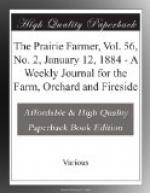New England Homestead: The early black cranberry is the popular early berry on Cape Cod. It escapes the early frosts and so the crop produces better prices. A larger, lighter and longer berry is the James P. Howley, which is being introduced in Essex county. The latter variety is not so early as the former, but bears well, and in the protected bogs along shore is frequently preferred.
Northwest Farmer: Mr. Edison Gaylord, of Floyd county, Iowa, advocates setting trees in a leaning posture, to prevent them from being killed by the combined effects of the wind and sun on their southwest side. Prof. J.L. Budd, of the Iowa Agricultural College, says, in confirmation of Mr. Gaylord’s view, he saw hundreds of the finer cherry and plum trees in Russia planted at an angle of forty-five degrees towards the one o’clock sun. He says that only for a short time will trees thus set have an awkward appearance.
The most convenient boxes in which to start seeds and cuttings are those known as “flats” among gardeners. A good size for the kitchen garden in which to start tomato seeds, etc., or for the ordinary conservatory, is two feet long, sixteen inches wide, and three inches deep. These shallow boxes are easy to handle, take up little room, and allow of much better drainage to the young plants. Salt or soap boxes can be easily cut up into three or four boxes three inches deep. Neat leather handles on each end of the box will increase its handiness. The bottom is better if made of several pieces of board, as the cracks insure good drainage.
James Vick’s plan of catching slugs is as follows: “Take some pieces of slate, or flat stones, or flat pieces of tin, and lay them about in the garden among the plants, distributing them very liberally; just at sundown go out and place a teaspoonful of bran on each piece of slate or tin, and the slugs will soon become aware of it, and begin to gather and feed on it. In about two hours, when it is dark, go out again with a lantern and a pail containing salt and water, and pick up each piece on which the slugs are found feeding, and throw slugs and bran into the brine, where they instantly die. It is well, also, to go around in the morning, and many slugs will be found hiding under the pieces of slate, and can be destroyed in the brine. By following up this method persistently for a few weeks the garden may be effectually rid of the nuisance.”
A correspondent of the Iowa Register advises us as to the proper manner of performing this operation: “To heel trees in properly, a trench should be dug on high, dry ground from two and a half to three feet deep; one side of which should slope from the bottom at an angle of 35 to 45 degrees. The trees should then be set against the sloping side of the trench and sufficiently apart to allow of fine earth being brought in close contact with every part of every root. When the roots and bodies of the trees are carefully covered, the trench should not only be filled but rounded up so as to form a mound over them. When air spaces are left among the roots they are liable to mould and rot. And very frequently, when they have not been buried sufficiently deep, the outside bark becomes detached from them and will slip off when they are being taken from the trench.”




